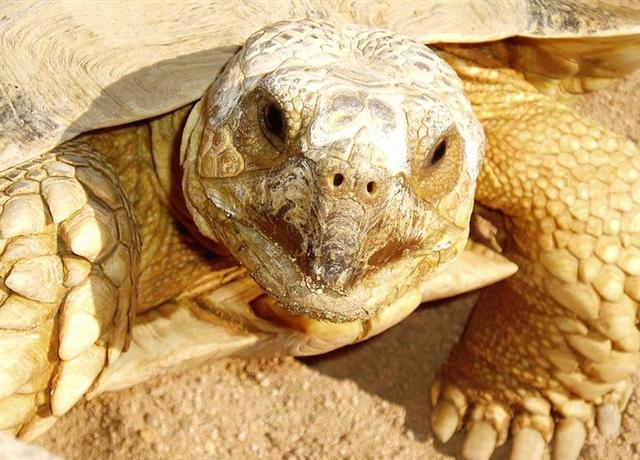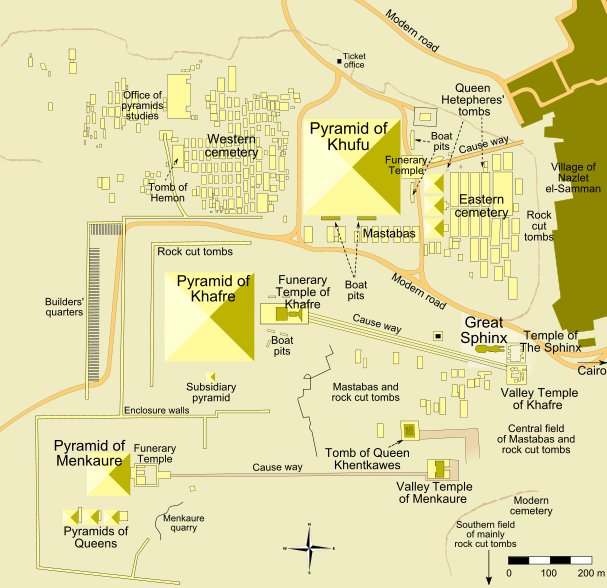1. In my astronomy book λ Orionis is listed as Heka:
Heka (alias Meissa) is quite close to declination 10º N and the evidence suggests this star (the 'head' of Orion) is where the old season is ending (= where the new season is beginning): "In Chinese ... 'Turtle Beak' ... refers to an asterism consisting of Meissa and both of φ Orionis. Consequently, Meissa itself is known as ... the 'First Star of Turtle Beak'." (Wikipedia) Maybe the curious 'spur' at front bottom in Ga1-19 represents the beak of a turtle. Picture of an African Spurred Tortoise:
Perhaps Heka is alluded to in the little 'subsidiary' pyramid of Khafre (probably alias Alnilam), because it lies on the same latitude as the end of the causeway leading from his Funerary Temple. At the end of his causeway lies the Great Sphinx together with both the Valley Temple of Khafre and of the Temple of the Sphinx, and this place seems to reflect, as if in a mirror, timespace back towards the Tomb of Queen Khentkawes:
Immediately below the Tomb of Queen Khentkawes is the Valley Temple of Menkaure, and this is connected to his pyramid (Mintaka) by a 'horizontal' causeway. A triangular form can be imagined, with the pyramids of Khafre and Menkaure marking 2 of the corners and the Valley Temple of Menkaure the 3rd. But there is not a right angle at the pyramid of Khafre. Perhaps the idea is to make us construct a right angle at the Khafre pyramid and then to search for the 3rd corner and possibly to find it at the Tomb of Queen Khentkawes. If so, then the peculiar dislocation of Menkaure's pyramid compared to the other two pyramids in away could 'reflect' the gap between the Tomb of Queen Khentkawes and the Valley Temple of Menkaure. But according to Wikipedia the tomb and the valley temple are interconnected: "A causeway connects the pyramid chapel to the valley temple of Khentkaus [Khentkawes]. The temple lies close to the valley temple of Menkaure which suggests a close relationship between Khentkaus and Menkaure. In front of the temple a small structure referred to as the 'washing tent of Queen Khentkaus' was discovered. This structure was the location where the body of the deceased queen would have been taken to be purified before being embalmed. The valley temple of Khentkaus and Menkaure were both partially constructed of mud-brick and finished with white limestone and alabaster. The main entrance is located on the northern side which is a departure form the more common situation where the main entrance is located to the east. Near the doorway a statue of King Khafra (father of Menkaure) once stood. Remains of a statue of a king (possibly Khafra) and the body of a sphinx statue were found in the vestibule of the temple. The vestibule opens up to a court which in turn led to the magazines." The direction east in the Giza system on the ground corresponds to the direction west in the sky and therefore the main entrance on the northern side will be on the southern side in the sky:  Right ascension increases to the east, for instance is Mintaka rising earlier than Heka. To map the sky on the ground it is necessary to invert the vertical dimension. This operiation, in turn, will change the front side (east) to be the back side (west) and the back side to be the front side, and we should remember Gb1-13:
The 'head' of Orion (Heka) will on a ground map be at the bottom of the figure. |

















